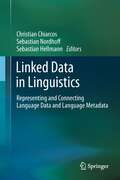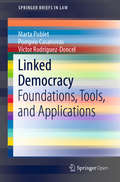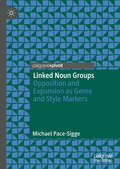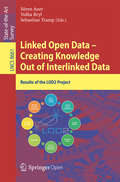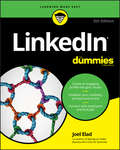- Table View
- List View
Link: How Decision Intelligence Connects Data, Actions, and Outcomes for a Better World
by Lorien PrattWhy aren't the most powerful new technologies being used to solve the world's most important problems: hunger, poverty, conflict, inequality, employment, disease? What's missing? From a pioneer in Artificial Intelligence and Machine Learning comes a thought-provoking book that answers these questions. In Link: How Decision Intelligence Connects Data, Actions, and Outcomes for a Better World, Dr. Lorien Pratt explores the solution that is emerging worldwide to take Artificial Intelligence to the next level: Decision Intelligence. Decision Intelligence (DI) goes beyond AI as well, connecting human decision makers in multiple areas like economics, optimization, big data, analytics, psychology, simulation, game theory, and more. Yet despite the sophistication of these approaches, Link shows how they can be used by you and me: connecting us in a way that supercharges our ability to meet the interconnected challenges of our age. Pratt tells the stories of decision intelligence pioneers worldwide, along with examples of their work in areas that include government budgeting, space exploration, emerging democracy conflict resolution, banking, leadership, and much more. Link delivers practical examples of how DI connects people to computers and to each other to help us solve complex interconnected problems. Link explores a variety of scenarios that show readers how to design solutions that change the way problems are considered, data is analyzed, and technologies work together with people. Technology and academics has accelerated beyond our ability to understand or effectively control them. Link brings technology down to earth and connects it to our more natural ways of thinking. It offers a roadmap to the future, empowering us all to make practical steps and take the best actions to solve the hardest problems.
Link-Layer Cooperative Communication in Vehicular Networks (Wireless Networks)
by Sailesh Bharati Weihua ZhuangThis book presents link-layer cooperative frameworks to improve transmission reliability and network throughput of distributed TDMA MAC protocols in vehicular ad hoc networks (VANETs). The main objective of this book is to present link-layer node cooperation schemes to enhance the link-layer performance of vehicular networks, in terms of reliability and system throughput. The authors present approaches proposed for the medium access control (MAC) and node cooperation in VANETs. The authors also cover cooperative ADHOC MAC for point-to-point communication between a pair of source and destination nodes, and cooperative relay broadcasting for broadcast services in this book. The performance of node cooperation frameworks is evaluated via mathematical analysis and computer simulations, in comparison with distributed TDMA MAC protocols without cooperation. The proposed node cooperation frameworks enhance the performance of distributed TDMA MAC and make it more robust to tackle the dynamic networking conditions in VANETs. Furthermore, with cooperation enabled transmission, the performance of distributed TMDA MAC is more suitable to support the wide range of mobile applications and their strict service requirements which is discussed in this book. The proposed node cooperation schemes and distributed cooperation decisions can be extended to wireless systems other than distributed TDMA MAC, such as cellular communication, for vehicular communications introduced in this book. This book is useful for researchers from academia and industry, as well as advanced level students interested in vehicular communication networks. It is also useful for professionals and engineers developing applications that use cooperative wireless communication systems.
Link Mining: Models, Algorithms, And Applications
by Philip S. Yu Jiawei Han Christos FaloutsosThis book offers detailed surveys and systematic discussion of models, algorithms and applications for link mining, focusing on theory and technique, and related applications: text mining, social network analysis, collaborative filtering and bioinformatics.
Link Prediction in Social Networks: Role of Power Law Distribution (SpringerBriefs in Computer Science)
by Srinivas Virinchi Pabitra MitraThis work presents link prediction similarity measures for social networks that exploit the degree distribution of the networks. In the context of link prediction in dense networks, the text proposes similarity measures based on Markov inequality degree thresholding (MIDTs), which only consider nodes whose degree is above a threshold for a possible link. Also presented are similarity measures based on cliques (CNC, AAC, RAC), which assign extra weight between nodes sharing a greater number of cliques. Additionally, a locally adaptive (LA) similarity measure is proposed that assigns different weights to common nodes based on the degree distribution of the local neighborhood and the degree distribution of the network. In the context of link prediction in dense networks, the text introduces a novel two-phase framework that adds edges to the sparse graph to forma boost graph.
Link Reversal Algorithms (Synthesis Lectures on Distributed Computing Theory)
by Jennifer Welch Jennifer WalterLink reversal is a versatile algorithm design technique that has been used in numerous distributed algorithms for a variety of problems. The common thread in these algorithms is that the distributed system is viewed as a graph, with vertices representing the computing nodes and edges representing some other feature of the system (for instance, point-to-point communication channels or a conflict relationship). Each algorithm assigns a virtual direction to the edges of the graph, producing a directed version of the original graph. As the algorithm proceeds, the virtual directions of some of the links in the graph change in order to accomplish some algorithm-specific goal. The criterion for changing link directions is based on information that is local to a node (such as the node having no outgoing links) and thus this approach scales well, a feature that is desirable for distributed algorithms. This monograph presents, in a tutorial way, a representative sampling of the work on link-reversal-based distributed algorithms. The algorithms considered solve routing, leader election, mutual exclusion, distributed queueing, scheduling, and resource allocation. The algorithms can be roughly divided into two types, those that assume a more abstract graph model of the networks, and those that take into account more realistic details of the system. In particular, these more realistic details include the communication between nodes, which may be through asynchronous message passing, and possible changes in the graph, for instance, due to movement of the nodes. We have not attempted to provide a comprehensive survey of all the literature on these topics. Instead, we have focused in depth on a smaller number of fundamental papers, whose common thread is that link reversal provides a way for nodes in the system to observe their local neighborhoods, take only local actions, and yet cause global problems to be solved. We conjecture that future interesting uses of link reversal are yet to be discovered. Table of Contents: Introduction / Routing in a Graph: Correctness / Routing in a Graph: Complexity / Routing and Leader Election in a Distributed System / Mutual Exclusion in a Distributed System / Distributed Queueing / Scheduling in a Graph / Resource Allocation in a Distributed System / Conclusion
Link Technology to Your Long-Term Business Goals: How to Use Technology to Mobilize Your People, Strategy and Operations
by PrazLink the use of technology with long-term business goals to optimize the core elements in your organization: people, strategy, and operations. This book will show you how effective planning of processes and execution of strategies with the help of technology can bring about an organization-wide increase in productivity and performance.Business environments have grown increasingly competitive. Before an organization realizes what has happened, it can lose or gain market share. Being agile is the key to success. This book covers the processes that can help your enterprise be agile and follow best practices when executing your business strategy.You'll review case studies from real-world experiences that dive deep into the problems a business encounters and the ways to solve those challenges. They deal with the different ways in which your organization can achieve dramatic performance improvements by changing your company’s processes. The book also explains how objectives and key results can be used to align business teams for increased productivity. With Use Tech to Mobilize Your People, Strategy, and Operations you'll learn how the intensity of core processes can ensure that growth does not wane in your organization. What You'll Learn Know the role of three core elements in organizations: people, strategy, operationsUnderstand how technology can enhance these three core elementsBe aware of the importance of scale and security in the information eraEliminate distractions and uncertainty in core processesWho This Book Is ForPeople with experience building businesses (founders, CEOs, COOs, CTOs, project managers, product managers, operation heads, sales heads, finance heads, strategy heads, technology leaders) who are looking for technology solutions to business problems
Linkage in Evolutionary Computation (Studies in Computational Intelligence #157)
by Ying-Ping ChenIn recent years, the issue of linkage in GEAs has garnered greater attention and recognition from researchers. Conventional approaches that rely much on ad hoc tweaking of parameters to control the search by balancing the level of exploitation and exploration are grossly inadequate. As shown in the work reported here, such parameters tweaking based approaches have their limits; they can be easily ”fooled” by cases of triviality or peculiarity of the class of problems that the algorithms are designed to handle. Furthermore, these approaches are usually blind to the interactions between the decision variables, thereby disrupting the partial solutions that are being built up along the way.
Linked: Conquer LinkedIn. Get Your Dream Job. Own Your Future.
by Omar Garriott Jeremy SchifelingA definitive guide to maximizing LinkedIn and navigating the changing hiring landscape. Written by hiring gurus Omar Garriott and Jeremy Schifeling, both former LinkedIn marketing heads with invaluable insider perspective the book lays out a five-step job search framework, tying each to discrete actions on LinkedIn.
Linked Data: Evolving the Web into a Global Data Space (Synthesis Lectures on Data, Semantics, and Knowledge)
by Tom Heath Christian BizerThe World Wide Web has enabled the creation of a global information space comprising linked documents. As the Web becomes ever more enmeshed with our daily lives, there is a growing desire for direct access to raw data not currently available on the Web or bound up in hypertext documents. Linked Data provides a publishing paradigm in which not only documents, but also data, can be a first class citizen of the Web, thereby enabling the extension of the Web with a global data space based on open standards - the Web of Data. In this Synthesis lecture we provide readers with a detailed technical introduction to Linked Data. We begin by outlining the basic principles of Linked Data, including coverage of relevant aspects of Web architecture. The remainder of the text is based around two main themes - the publication and consumption of Linked Data. Drawing on a practical Linked Data scenario, we provide guidance and best practices on: architectural approaches to publishing Linked Data; choosing URIs and vocabularies to identify and describe resources; deciding what data to return in a description of a resource on the Web; methods and frameworks for automated linking of data sets; and testing and debugging approaches for Linked Data deployments. We give an overview of existing Linked Data applications and then examine the architectures that are used to consume Linked Data from the Web, alongside existing tools and frameworks that enable these. Readers can expect to gain a rich technical understanding of Linked Data fundamentals, as the basis for application development, research or further study. Table of Contents: List of Figures / Introduction / Principles of Linked Data / The Web of Data / Linked Data Design Considerations / Recipes for Publishing Linked Data / Consuming Linked Data / Summary and Outlook
Linked Data: Storing, Querying, and Reasoning
by Sherif Sakr Marcin Wylot Raghava Mutharaju Danh Le Phuoc Irini FundulakiThis book describes efficient and effective techniques for harnessing the power of Linked Data by tackling the various aspects of managing its growing volume: storing, querying, reasoning, provenance management and benchmarking.To this end, Chapter 1 introduces the main concepts of the Semantic Web and Linked Data and provides a roadmap for the book. Next, Chapter 2 briefly presents the basic concepts underpinning Linked Data technologies that are discussed in the book. Chapter 3 then offers an overview of various techniques and systems for centrally querying RDF datasets, and Chapter 4 outlines various techniques and systems for efficiently querying large RDF datasets in distributed environments. Subsequently, Chapter 5 explores how streaming requirements are addressed in current, state-of-the-art RDF stream data processing. Chapter 6 covers performance and scaling issues of distributed RDF reasoning systems, while Chapter 7 details benchmarks for RDF query engines and instance matching systems. Chapter 8 addresses the provenance management for Linked Data and presents the different provenance models developed. Lastly, Chapter 9 offers a brief summary, highlighting and providing insights into some of the open challenges and research directions.Providing an updated overview of methods, technologies and systems related to Linked Data this book is mainly intended for students and researchers who are interested in the Linked Data domain. It enables students to gain an understanding of the foundations and underpinning technologies and standards for Linked Data, while researchers benefit from the in-depth coverage of the emerging and ongoing advances in Linked Data storing, querying, reasoning, and provenance management systems. Further, it serves as a starting point to tackle the next research challenges in the domain of Linked Data management.
Linked Data and Knowledge Graph: Seventh Chinese Semantic Web Symposium and the Second Chinese Web Science Conference, CSWS 2013, Shanghai, China, August 12-16, 2013. Revised Selected Papers (Communications in Computer and Information Science #406)
by Guilin Qi Jie Tang Jianfeng Du Jeff Z. Pan Yong YuThis book constitutes the refereed proceedings of the Seventh Chinese Semantic Web Symposium and the Second Chinese Web Science Conference, CSWS 2013, held in Shanghai, China in August 2013. The 14 revised full papers presented together with 6 short papers and 3 poster papers were carefully reviewed and selected from 48 submissions. The papers cover a wide range of topics, including semantic search, ontology reasoning, social semantic Web, knowledge graph, etc.
Linked Data for Digital Humanities (ISSN)
by Terhi Nurmikko-FullerLinked Data for Digital Humanities provides insights into how digital technologies can enrich and diversify humanities scholarship and make it pioneering in the digital age.Written in non-specialist language, the book illustrates how information is captured, published, represented, accessed, and interpreted using computational systems and, in doing so, shows how technologies actively shape the way we understand what we encounter. Focusing as it does on underlying Web architecture and projects accessible online, the book has an inherently international focus. The interdisciplinary case study examples include bibliographic data from works published in England between 1470 and 1700; literature from ancient Iraq; jazz performances, predominantly from the USA in the 1930s; and even reach as far as an alien, fictional future. Whilst these case study examples span vast spatio-temporal distances, they all share a common thread in the use of the Linked Data information publication paradigm. Using existing computer science methods, as well as processes such as ontology development and database design, the book also includes reflections on practical considerations and offers advice about how to take institutional policies, socio-cultural sensitivities, and economic models into consideration when implementing Linked Data projects.Linked Data for Digital Humanities discusses technological issues in the context of Humanities scholarship, bridging disciplines and enabling informed conversations across disciplinary boundaries. It will be of interest to humanities scholars, computer and data scientists, and library and information scientists.
Linked Data for Digital Humanities (ISSN)
by Terhi Nurmikko-FullerLinked Data for Digital Humanities provides insights into how digital technologies can enrich and diversify humanities scholarship and make it pioneering in the digital age.Written in non-specialist language, the book illustrates how information is captured, published, represented, accessed, and interpreted using computational systems and, in doing so, shows how technologies actively shape the way we understand what we encounter. Focusing as it does on underlying Web architecture and projects accessible online, the book has an inherently international focus. The interdisciplinary case study examples include bibliographic data from works published in England between 1470 and 1700; literature from ancient Iraq; jazz performances, predominantly from the USA in the 1930s; and even reach as far as an alien, fictional future. Whilst these case study examples span vast spatio-temporal distances, they all share a common thread in the use of the Linked Data information publication paradigm. Using existing computer science methods, as well as processes such as ontology development and database design, the book also includes reflections on practical considerations and offers advice about how to take institutional policies, socio-cultural sensitivities, and economic models into consideration when implementing Linked Data projects.Linked Data for Digital Humanities discusses technological issues in the context of Humanities scholarship, bridging disciplines and enabling informed conversations across disciplinary boundaries. It will be of interest to humanities scholars, computer and data scientists, and library and information scientists.
Linked Data in Linguistics: Representing and Connecting Language Data and Language Metadata
by Christian Chiarcos Sebastian Nordhoff Sebastian HellmannThe explosion of information technology has led to substantial growth of web-accessible linguistic data in terms of quantity, diversity and complexity. These resources become even more useful when interlinked with each other to generate network effects.The general trend of providing data online is thus accompanied by newly developing methodologies to interconnect linguistic data and metadata. This includes linguistic data collections, general-purpose knowledge bases (e.g., the DBpedia, a machine-readable edition of the Wikipedia), and repositories with specific information about languages, linguistic categories and phenomena. The Linked Data paradigm provides a framework for interoperability and access management, and thereby allows to integrate information from such a diverse set of resources.The contributions assembled in this volume illustrate the band-width of applications of the Linked Data paradigm for representative types of language resources. They cover lexical-semantic resources, annotated corpora, typological databases as well as terminology and metadata repositories. The book includes representative applications from diverse fields, ranging from academic linguistics (e.g., typology and corpus linguistics) over applied linguistics (e.g., lexicography and translation studies) to technical applications (in computational linguistics, Natural Language Processing and information technology).This volume accompanies the Workshop on Linked Data in Linguistics 2012 (LDL-2012) in Frankfurt/M., Germany, organized by the Open Linguistics Working Group (OWLG) of the Open Knowledge Foundation (OKFN). It assembles contributions of the workshop participants and, beyond this, it summarizes initial steps in the formation of a Linked Open Data cloud of linguistic resources, the Linguistic Linked Open Data cloud (LLOD).
Linked Data Management
by Andreas Harth Katja Hose Ralf SchenkelLinked Data Management presents techniques for querying and managing Linked Data that is available on today's Web. The book shows how the abundance of Linked Data can serve as fertile ground for research and commercial applications.The text focuses on aspects of managing large-scale collections of Linked Data. It offers a detailed introduction to L
Linked Data Management (Emerging Directions in Database Systems and Applications)
by Katja Hose Andreas Harth Ralf SchenkelLinked Data Management presents techniques for querying and managing Linked Data that is available on today's Web. The book shows how the abundance of Linked Data can serve as fertile ground for research and commercial applications.The text focuses on aspects of managing large-scale collections of Linked Data. It offers a detailed introduction to L
Linked Data Management (Emerging Directions in Database Systems and Applications)
by Katja Hose Andreas Harth Ralf SchenkelLinked Data Management presents techniques for querying and managing Linked Data that is available on today's Web. The book shows how the abundance of Linked Data can serve as fertile ground for research and commercial applications.The text focuses on aspects of managing large-scale collections of Linked Data. It offers a detailed introduction to L
Linked Data Visualization: Techniques, Tools, and Big Data (Synthesis Lectures on Data, Semantics, and Knowledge)
by Laura Po Nikos Bikakis Federico Desimoni George PapastefanatosLinked Data (LD) is a well-established standard for publishing and managing structured information on the Web, gathering and bridging together knowledge from different scientific and commercial domains. The development of Linked Data Visualization techniques and tools has been followed as the primary means for the analysis of this vast amount of information by data scientists, domain experts, business users, and citizens. This book covers a wide spectrum of visualization issues, providing an overview of the recent advances in this area, focusing on techniques, tools, and use cases of visualization and visual analysis of LD. It presents the basic concepts related to data visualization and the LD technologies, the techniques employed for data visualization based on the characteristics of data techniques for Big Data visualization, use tools and use cases in the LD context, and finally a thorough assessment of the usability of these tools under different scenarios. The purpose of this book is to offer a complete guide to the evolution of LD visualization for interested readers from any background and to empower them to get started with the visual analysis of such data. This book can serve as a course textbook or a primer for all those interested in LD and data visualization.
Linked Democracy: Foundations, Tools, and Applications (SpringerBriefs in Law)
by Marta Poblet Pompeu Casanovas Víctor Rodríguez-DoncelThis open access book shows the factors linking information flow, social intelligence, rights management and modelling with epistemic democracy, offering licensed linked data along with information about the rights involved. This model of democracy for the web of data brings new challenges for the social organisation of knowledge, collective innovation, and the coordination of actions. Licensed linked data, licensed linguistic linked data, right expression languages, semantic web regulatory models, electronic institutions, artificial socio-cognitive systems are examples of regulatory and institutional design (regulations by design). The web has been massively populated with both data and services, and semantically structured data, the linked data cloud, facilitates and fosters human-machine interaction. Linked data aims to create ecosystems to make it possible to browse, discover, exploit and reuse data sets for applications. Rights Expression Languages semi-automatically regulate the use and reuse of content.
Linked Enterprise Data: Management und Bewirtschaftung vernetzter Unternehmensdaten mit Semantic Web Technologien (X.media.press)
by Tassilo Pellegrini Harald Sack Sören AuerDie Herausgeber und Autoren führen praxisnah in neue Methoden und Technologien des (Meta-)Daten-Managements für die Vernetzung und Integration verteilter, heterogener Datenbestände ein. Dabei werden die neuen Technologien und Methoden von bereits etablierten Ansätzen deutlich abgegrenzt, ihre Potenziale und auch ihre Grenzen klar benannt. Vor allem Semantic-Web-Technologien, deren betrieblicher Einsatz anhand anschaulicher Fallstudien erläutert wird, spielen eine zentrale Rolle.
Linked Lexical Knowledge Bases: Foundations and Applications (Synthesis Lectures on Human Language Technologies)
by Iryna Gurevych Judith Eckle-Kohler Michael MatuschekThis book conveys the fundamentals of Linked Lexical Knowledge Bases (LLKB) and sheds light on their different aspects from various perspectives, focusing on their construction and use in natural language processing (NLP). It characterizes a wide range of both expert-based and collaboratively constructed lexical knowledge bases. Only basic familiarity with NLP is required and this book has been written for both students and researchers in NLP and related fields who are interested in knowledge-based approaches to language analysis and their applications. Lexical Knowledge Bases (LKBs) are indispensable in many areas of natural language processing, as they encode human knowledge of language in machine readable form, and as such, they are required as a reference when machines attempt to interpret natural language in accordance with human perception. In recent years, numerous research efforts have led to the insight that to make the best use of available knowledge, the orchestrated exploitation of different LKBs is necessary. This allows us to not only extend the range of covered words and senses, but also gives us the opportunity to obtain a richer knowledge representation when a particular meaning of a word is covered in more than one resource. Examples where such an orchestrated usage of LKBs proved beneficial include word sense disambiguation, semantic role labeling, semantic parsing, and text classification. This book presents different kinds of automatic, manual, and collaborative linkings between LKBs. A special chapter is devoted to the linking algorithms employing text-based, graph-based, and joint modeling methods. Following this, it presents a set of higher-level NLP tasks and algorithms, effectively utilizing the knowledge in LLKBs. Among them, you will find advanced methods, e.g., distant supervision, or continuous vector space models of knowledge bases (KB), that have become widely used at the time of this book's writing. Finally, multilingual applications of LLKB's, such as cross-lingual semantic relatedness and computer-aided translation are discussed, as well as tools and interfaces for exploring LLKBs, followed by conclusions and future research directions.
Linked Noun Groups: Opposition and Expansion as Genre and Style Markers
by Michael Pace-SiggeThis book provides a corpus-led analysis of multi-word units (MWUs) in English, specifically fixed pairs of nouns which are linked by a conjunction, such as 'mum and dad', 'bride and groom' and 'law and order'. Crucially, the occurrence pattern of such pairs is dependent on genre, and this book aims to document the structural distribution of some key Linked Noun Groups (LNGs). The author looks at the usage patterns found in a range of poetry and fiction dating from the 17th to 20th century, and also highlights the important role such binomials play in academic English, while acknowledging that they are far less common in casual spoken English. His findings will be highly relevant to students and scholars working in language teaching, stylistics, and language technology (including AI).
Linked Open Data -- Creating Knowledge Out of Interlinked Data: Results of the LOD2 Project (Lecture Notes in Computer Science #8661)
by Sören Auer Volha Bryl Sebastian TrampLinked Open Data (LOD) is a pragmatic approach for realizing the Semantic Web vision of making the Web a global, distributed, semantics-based information system. This book presents an overview on the results of the research project “LOD2 -- Creating Knowledge out of Interlinked Data”. LOD2 is a large-scale integrating project co-funded by the European Commission within the FP7 Information and Communication Technologies Work Program. Commencing in September 2010, this 4-year project comprised leading Linked Open Data research groups, companies, and service providers from across 11 European countries and South Korea. The aim of this project was to advance the state-of-the-art in research and development in four key areas relevant for Linked Data, namely 1. RDF data management; 2. the extraction, creation, and enrichment of structured RDF data; 3. the interlinking and fusion of Linked Data from different sources and 4. the authoring, exploration and visualization of Linked Data.
LinkedIn For Dummies
by Joel EladMake LinkedIn your number one professional branding tool LinkedIn is the premiere social network for professionals looking to discover new opportunities, enhance personal branding, connect with other professionals, and make career advancements. With LinkedIn For Dummies, you’ll have step-by-step instructions on how to take advantage of the latest tools and features to do all of this and more. This book will teach you how to create an attractive profile that employers will notice, as well as ways to expand your network by making connections around the globe. You'll also learn how to best navigate the new user interface, write recommendations, take a course with LinkedIn Learning, and conduct your job search. Create an appealing, detailed profile Establish your credibility and personal brand Connect with employers and find jobs Request and write recommendations Whether you’re one of LinkedIn’s 500 million global members or brand new to the site, this authoritative resource helps you get the most out of the world’s largest professional network.
LinkedIn For Dummies
by Joel EladMake LinkedIn your number one professional branding tool LinkedIn is the premiere social network for professionals looking to discover new opportunities, enhance personal branding, connect with other professionals, and make career advancements. With LinkedIn For Dummies, you’ll have step-by-step instructions on how to take advantage of the latest tools and features to do all of this and more. This book will teach you how to create an attractive profile that employers will notice, as well as ways to expand your network by making connections around the globe. You'll also learn how to best navigate the new user interface, write recommendations, take a course with LinkedIn Learning, and conduct your job search. Create an appealing, detailed profile Establish your credibility and personal brand Connect with employers and find jobs Request and write recommendations Whether you’re one of LinkedIn’s 500 million global members or brand new to the site, this authoritative resource helps you get the most out of the world’s largest professional network.












